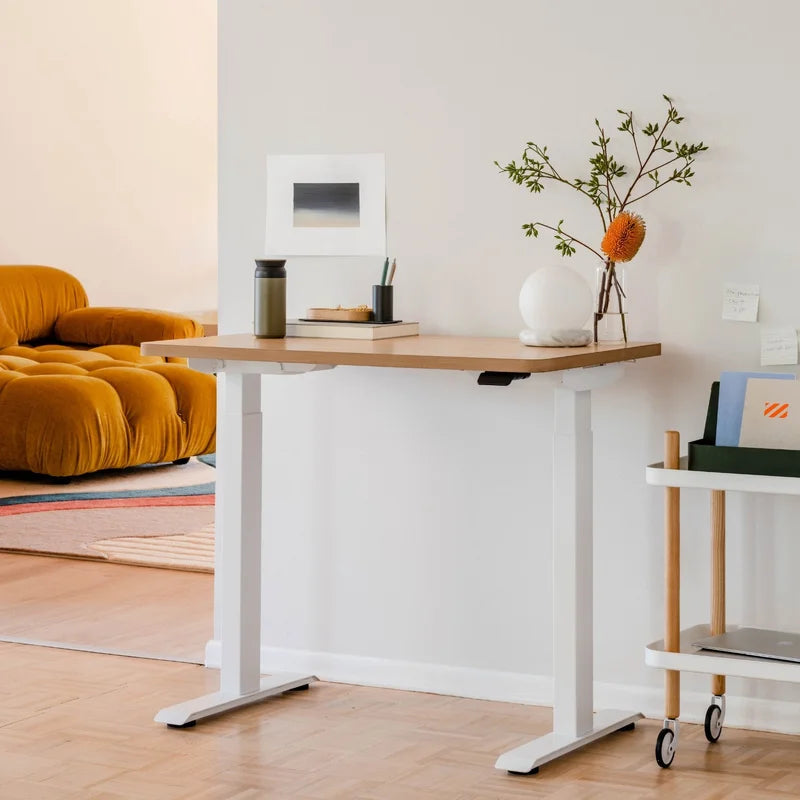1. Prolonged Standing Discomfort
Problem: While standing desks promote movement, prolonged standing can lead to discomfort or even pain in the lower back, legs, and feet, especially for users who are new to standing for extended periods. Over time, standing without proper posture or support can lead to muscle fatigue and joint pain.
Solution:
• Alternate Sitting and Standing: The 30-30 rule is a great starting point—stand for 30 minutes, sit for 30 minutes. But remember that even small posture changes every 10–15 minutes can make a significant difference. Alternating frequently helps to avoid muscle stiffness and promotes circulation, which is essential for maintaining energy levels throughout the day.
• Incorporate Stretching and Movement: Adding light stretches and short walking breaks every hour can relieve tension in the legs, hips, and lower back. Simple stretches, like calf raises, hamstring stretches, and shoulder rolls, can relieve tightness and prevent the build-up of fatigue.
• Anti-Fatigue Mat: An anti-fatigue mat encourages small movements in the feet and leg muscles, which keeps blood flowing and reduces the stress on joints. Mats with a slightly cushioned texture are best for prolonged standing and can make standing feel more comfortable and natural.
2. Desk Wobbling
Problem: Desk wobbling is a common issue, especially at taller desk heights or with lightweight frames. A wobbly desk can disrupt your workflow, distract you, and even damage delicate equipment like monitors.
Solution:
• Check Assembly: Go through the desk assembly instructions carefully, as improperly installed screws or loose bolts can make the desk unstable. Tightening everything securely can improve the desk’s stability.
• Place on a Level Surface: Uneven floors can contribute to wobbling. Many standing desks have adjustable feet to counterbalance slight floor irregularities. Make sure to adjust each foot until the desk sits firmly and evenly on the ground.
• Choose a Robust Frame: Desks with a wider, heavier base or with additional crossbars are generally more stable. Dual motor desks, in particular, tend to offer more stability due to their solid frames, which support the desk at two points instead of one.
3. Improper Desk Height
Problem: An improperly set desk height can cause strain on your wrists, shoulders, neck, and back. The wrong height disrupts your ergonomic alignment and can lead to repetitive strain injuries over time.
Solution:
• Adjust for Optimal Ergonomics: To find the right height, stand with your arms at your sides and bend your elbows to a 90-degree angle. The desk surface should be at the same level as your forearms when typing. This setup helps maintain a neutral wrist position, reducing strain.
• Set Monitor at Eye Level: Adjust the height of your monitor so the top of the screen is at or slightly below eye level. This prevents you from looking down, which can strain the neck and shoulders. A monitor arm or riser is helpful to achieve the correct monitor height, especially if you have multiple screens.
• Use Memory Presets: Many electric standing desks come with memory presets. Set one preset for your sitting height and another for standing. This makes it easy to switch back and forth without having to readjust each time, maintaining your preferred ergonomic settings.
4. Cable Management Issues
Problem: Adjustable desks move up and down, which can stretch, tangle, or disconnect cables if they aren’t managed properly. Poor cable management can not only disrupt your workspace but also pose safety hazards.
Solution:
• Invest in Cable Management Accessories: Cable clips, trays, and sleeves keep cords organized and prevent them from tangling or getting in the way. By securing cables to the underside of the desk, you can prevent them from interfering with the desk’s movement.
• Use Cable Management Kits with Flexibility: Coiled or spiral cable organizers are ideal for standing desks as they expand and contract with the desk’s movement, reducing strain on the cables.
• Secure Cables to the Desk Frame: Attach power strips and adapters to the underside of the desk frame using adhesive strips or cable ties. This keeps everything in one place, reducing the chance of cords getting tangled or pulled out as the desk moves.
5. Monitor Positioning Problems
Problem: Incorrect monitor positioning can lead to neck, shoulder, and eye strain. When the monitor is too low or too far from your eyes, you’re forced to adjust your posture in ways that can strain your body.
Solution:
• Use a Monitor Arm: Monitor arms are adjustable mounts that allow you to set your monitor at the perfect height, tilt, and angle. This flexibility is crucial for reducing strain, especially if you use multiple monitors, as you can position each screen to align with your line of sight.
• Set the Proper Distance: Place your monitor about an arm’s length (20–30 inches or 50–75 cm) away from your eyes. If you’re using multiple monitors, angle them slightly towards you to avoid excessive neck turning.
• Angle Your Monitor: A slight downward tilt (10-20 degrees) of the monitor can help reduce glare and keep the screen in a comfortable position for your eyes. This setup helps prevent you from craning your neck or leaning forward.
6. Foot and Leg Discomfort
Problem: Standing on hard surfaces, especially for extended periods, can cause foot pain, leg discomfort, and fatigue. This is particularly common if you’re wearing hard-soled or unsupportive shoes.
Solution:
• Use an Anti-Fatigue Mat: These mats have a cushioned surface that reduces the impact on your feet and legs while standing. They promote subtle movements, which improve circulation and reduce fatigue. Look for mats with varied textures or raised surfaces to encourage shifting weight from one foot to the other.
• Wear Supportive Shoes: If you stand for long periods, wearing comfortable, supportive shoes can make a big difference. Avoid standing barefoot or in high heels, as this can contribute to foot and leg strain.
• Change Positions Frequently: Shift your weight from one leg to the other, and occasionally bend your knees or perform calf raises to reduce the load on your legs and feet. Taking mini-breaks to walk around can also help refresh your muscles.
7. Desk Malfunctions
Problem: Electric standing desks may encounter technical issues, such as unresponsiveness, error codes, or motor failures. Malfunctions can prevent the desk from adjusting properly, leading to frustration and limited functionality.
Solution:
• Follow Troubleshooting Guides: Most standing desks come with a troubleshooting guide that explains how to resolve common issues, like unresponsiveness or error codes. Start with a reset by unplugging the desk for a few minutes, then plugging it back in to reset the motor.
• Check All Connections: Loose cables or power adapters can sometimes cause malfunctions. Make sure everything is securely connected and that the power source is working correctly.
• Consult Customer Support: If troubleshooting doesn’t resolve the issue, reach out to the manufacturer’s customer support team for assistance. Many companies offer warranties on motors, so if the issue is more serious, you may be able to get a replacement or repair.
Additional Tips for a Better Standing Desk Experience
• Practice Good Posture: Whether sitting or standing, keep your shoulders relaxed, elbows at a 90-degree angle, and feet flat (if sitting) or hip-width apart (if standing).
• Take Breaks: Using a standing desk doesn’t eliminate the need for movement. Take breaks to stretch, walk, or move around to maintain energy and comfort.
• Personalize Your Workspace: Add ergonomic accessories like a footrest, wrist support, or ergonomic chair to make the most out of your standing desk setup.
By addressing these common standing desk challenges, you can enhance the comfort, functionality, and overall ergonomics of your workspace. A well-organized, ergonomically sound standing desk setup helps you stay productive and healthy throughout the workday.


Share:
Single vs. Dual Motor for Standing Desks: Which One is Right for You?
Comparing MDF vs. Particle Board: Which Wood is Best for Your Standing Desk?